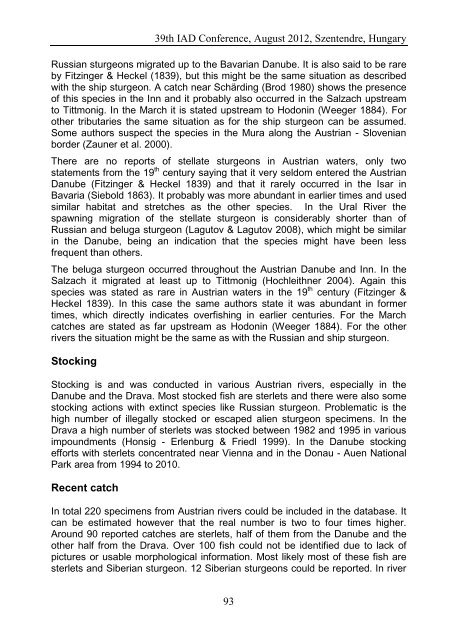Conference Proceedings - IAD
Conference Proceedings - IAD
Conference Proceedings - IAD
Create successful ePaper yourself
Turn your PDF publications into a flip-book with our unique Google optimized e-Paper software.
39th <strong>IAD</strong> <strong>Conference</strong>, August 2012, Szentendre, Hungary<br />
Russian sturgeons migrated up to the Bavarian Danube. It is also said to be rare<br />
by Fitzinger & Heckel (1839), but this might be the same situation as described<br />
with the ship sturgeon. A catch near Schärding (Brod 1980) shows the presence<br />
of this species in the Inn and it probably also occurred in the Salzach upstream<br />
to Tittmonig. In the March it is stated upstream to Hodonin (Weeger 1884). For<br />
other tributaries the same situation as for the ship sturgeon can be assumed.<br />
Some authors suspect the species in the Mura along the Austrian - Slovenian<br />
border (Zauner et al. 2000).<br />
There are no reports of stellate sturgeons in Austrian waters, only two<br />
statements from the 19 th century saying that it very seldom entered the Austrian<br />
Danube (Fitzinger & Heckel 1839) and that it rarely occurred in the Isar in<br />
Bavaria (Siebold 1863). It probably was more abundant in earlier times and used<br />
similar habitat and stretches as the other species. In the Ural River the<br />
spawning migration of the stellate sturgeon is considerably shorter than of<br />
Russian and beluga sturgeon (Lagutov & Lagutov 2008), which might be similar<br />
in the Danube, being an indication that the species might have been less<br />
frequent than others.<br />
The beluga sturgeon occurred throughout the Austrian Danube and Inn. In the<br />
Salzach it migrated at least up to Tittmonig (Hochleithner 2004). Again this<br />
species was stated as rare in Austrian waters in the 19 th century (Fitzinger &<br />
Heckel 1839). In this case the same authors state it was abundant in former<br />
times, which directly indicates overfishing in earlier centuries. For the March<br />
catches are stated as far upstream as Hodonin (Weeger 1884). For the other<br />
rivers the situation might be the same as with the Russian and ship sturgeon.<br />
Stocking<br />
Stocking is and was conducted in various Austrian rivers, especially in the<br />
Danube and the Drava. Most stocked fish are sterlets and there were also some<br />
stocking actions with extinct species like Russian sturgeon. Problematic is the<br />
high number of illegally stocked or escaped alien sturgeon specimens. In the<br />
Drava a high number of sterlets was stocked between 1982 and 1995 in various<br />
impoundments (Honsig - Erlenburg & Friedl 1999). In the Danube stocking<br />
efforts with sterlets concentrated near Vienna and in the Donau - Auen National<br />
Park area from 1994 to 2010.<br />
Recent catch<br />
In total 220 specimens from Austrian rivers could be included in the database. It<br />
can be estimated however that the real number is two to four times higher.<br />
Around 90 reported catches are sterlets, half of them from the Danube and the<br />
other half from the Drava. Over 100 fish could not be identified due to lack of<br />
pictures or usable morphological information. Most likely most of these fish are<br />
sterlets and Siberian sturgeon. 12 Siberian sturgeons could be reported. In river<br />
93
















